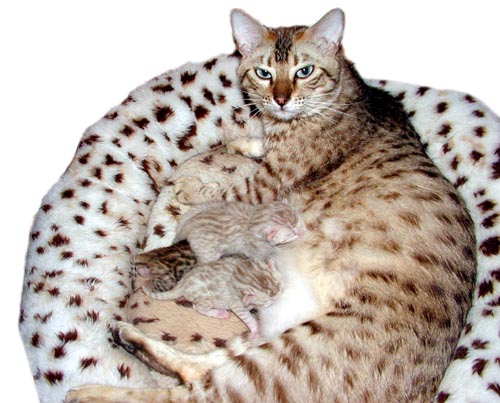
QCH Foothill Felines Mochamelo, a seal mink snow spotted Bengal female,
with her litter of snow and brown spotted kittens.

QCH Foothill Felines Mochamelo, a seal mink snow spotted Bengal female,
with her litter of snow and brown spotted kittens.
THE FASCINATING TOPIC OF THE GENETICS OF COLORS AND PATTERNS IN CATS!! |
Have you ever been confused by the bewildering number of terms used to describe the colors of a cat?
Actually, there are only two basic colors for cats: black and red (sometimes referred to as "orange"). Other colors and patterns are simply variations on these, and they can combine in some truly unique and fascinating ways.
Non-agouti, or self-colored cats can also be called "solid" cats. When the cat's body and fur are entirely one color, with no flecks of another color, we can refer to them as "solid" colored cats. Solid cats come in seven colors: black, chocolate, cinnamon, white, blue, lavender and fawn. Only the first four colors listed are the true solid colors, and the latter three are referred to as "dilute colors", which means that they are lighter versions of the solid. Blue is the dilute of black; lavender is the dilute of chocolate, fawn is the dilute of cinnamon.
• BLACK: With black cats, the hairs are solid black from base to tip. A black cat, which has long been associated with witches and bad luck, has black or dark slate grey toe pads and a black nose. A true black cat has orange eyes, but many will have gold to green eyes as well. If these black cats are exposed to sunlight, many will experience a brownish tinge to the fur, referred to as "rust". By trimming the black cat's coat during the warmer months, the glossy black color can easily be restored in most cases.
• CHOCOLATE: Brown, or chocolate, is often seen as a base color, but rarely as a solid color cat (except in breeds like the Burmese). The toepads and nose leather of the brown/chocolate cat range from pink to dark brown. The Havana Brown is the only purebred feline that is primarily chocolate colored, although this color is now being carefully selected in breeding programs for the Oriental Shorthairs and Persians. This color appears as a rich, warm brown.
• CINNAMON: Sometimes called "red", this color is extremely rare in purebreds with the exception of some Abyssinians and Somalis. The toepads and nose leather of an orante cat are pink, and the hairs are again one solid color from base to tip UNLESS marked with tabby markings. Sometimes, this color is referred to as "ginger" (or, in the case of Bengals, "sorrel").
• WHITE: White cats are true phenomena, in so many ways. White is actually the ABSENCE of color, at least in cats, and is similar to an albino animal. White cats often have blue eyes, and blue-eyed white cats may be deaf in many cases. Occasionally, a white cat may have one green eye and one blue eye. These cats are often deaf in the ear which corresponds to the blue eye. The white cat cannot make the pigment which causes the coat color. White is sometimes referred to as "dominant white", as the white coloration gene masks or covers up all other colors! Underneath each and every white cat is a different color cat with all the genes necessary for other coat colors and patterns; however, the white gene has suppressed them (dominated them).
 CLICK ON KITTY to return to top of page!
CLICK ON KITTY to return to top of page!
• BLUE: Blue cats are dilute examples of black cats, and are sometimes (erroneously) referred to as "grey" cats. A true "blue" coat is a rich blue-grey in color. Three breeds, the Chartreux, Russian Blue, and Korat, have almost exclusively blue coats. Blues can occur in the Bengal breed, as a result of this gene being carried over from the domestic cats used in the early creation of the breed. Both parents must carry this gene and pass it on for blue offspring to occur. There can be blue spotted or marbled Bengal tabbies; blue lynxpoint spotted or marbled Bengal tabbies; blue mink spotted or marbled Bengal tabbies, and blue sepia spotted or marbled Bengal tabbies.
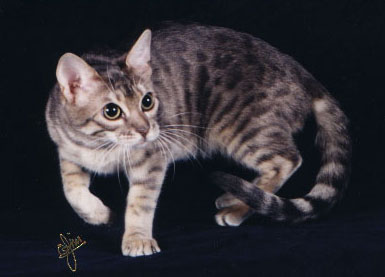
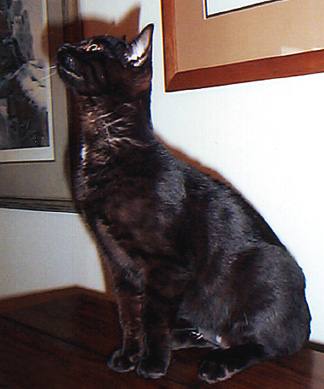
Above, two lovely Bengal Cat queens from
our cattery, Foothill Felines Bengals.
Left is Moodie Blue, a blue spotted tabby; right
is Catori, a melanistic (black) spotted tabby.
Blue is the dilute color of black. In
the wild, black panthers are actually melanistic leopards.
• LAVENDAR:
You will hear lavender sometimes referred to as "lilac". The lavender cat is a frosty grey-brown that actually does have a lavender tint in certain lights. Solid lavender is uncommon, even in pedigreed cats, just like its solid color counterpart, chocolate.
• FAWN: Fawn is the dilute color of cinnamon, and, like cinnamon, is very rare in pedigreed cats and almost non-existent in mixed breeds. Fawn, which is a pale beige with golden undertones, is sometimes confused with "cream", which is an almost peachy off-white.
 CLICK ON KITTY to return to top of page!
CLICK ON KITTY to return to top of page!
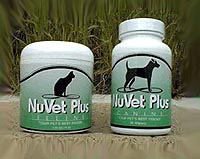
~ Click on image above for more information and to order this uniquely powerful nutritional supplement for felines at our Foothill Felines breeder discount (which is up to 50% less than what veterinarians typically charge). Used and recommended by Foothill Felines, just a pinch a day in wet and/or dry food provides vibrant results with all ages, weights and breeds of cats. Developed by scientists, veterinarians and formulators to enhance the health and lives of cats, this unique Nu- Vet supplement contains many important minerals, antioxidants, enzymes and vitamins INCLUDING taurine, calcium, blue green algae, brewer's yeast, and much more. Many studies show that the ingredients in this supplement are especially important during pregnancy to promote healthy kitten development in utero and maintain strong immune systems in the queen and her kittens. ~
The term "bicolor" refers to a cat having two, or sometimes, three different colors. A bicolor most often describes a cat with solid or tabby coloration in large areas, with substantial portions of white. Yet, a cat is still considered to be "bicolor" even if the white sections are as small as white boots or mittens, or as large as a cat that has white everywhere on its body with the exception of a splotch of color on its body or tail.
The famous "Tuxedo Cat" including our current First Cat, Socks, is actually a black and white bicolored cat. Actually, any tabby with white is also considered to be a bicolor, which is where the three colors can occur. The Maine Coon often has this attractive tabby patterning with white chest, white mittens, and even a face mask of the purest white. Other examples of bi-colored cats are the Turkish Van, with is colored cap and tail, and the Birman, with its four white mittens.
 CLICK ON KITTY to return to top of page!
CLICK ON KITTY to return to top of page!
There is a gene that inhibits the development of pigment on the hairs and results in a wide range of beautiful patterns. This gene most often affects the lighter hues of the coat, and can cause colors such as "silver", "smoke", "shaded", "chinchilla", "cameo", and "shell".
What does a "silver" cat mean? The gene that produces silver shading in a dark tabby causes the lighter shade between the dark stripes to become an almost white-silver, very pale color. On a ticked tabby, the ticking color remains, but the undercoat turns a very pale, silvery white. A brown (black) tabby can have a very striking contrast between the inky black stripes and a silver-white ground color. A blue-silver tabby retains its slate-blue spotting or striping, but shows a white-silver color instead of the paler blue between its stripes or spots.
What does a "smoke" cat mean? A smoke cat may look like a solid colored cat until the hair is ruffled backward, revealing white roots. This can happen when the gene that causes the pigment in the individual hairs starts to disappear on the hair, starting from the root upward.

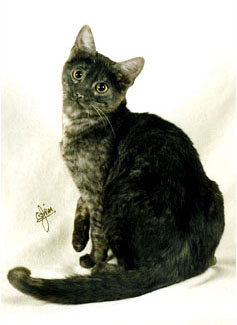
Above, meet two Savannah Cat queens from
our cattery, Foothill Felines Savannahs.
Left is Spooky Spots, an F3 silver spotted tabby; right
is Sinder Spots, an F4 smoke spotted
tabby. Sinder's dam is a brown spotted Savannah; her sire
is a silver spotted Bengal.
What is a "chinchilla" cat? As mentioned above, when the pigment starts to disappear on the hair, this can cause several different patterns. The chinchilla pattern occurs when the pigment remains only on the very tips of the hair.
What is a "shaded" cat? Between the smoke and the chinchilla pattern is a cat called the shaded silver . This pattern has more pigment on the hair tips than chinchilla, but less than the smoke.
 CLICK ON KITTY to return to top of page!
CLICK ON KITTY to return to top of page!
The cream tabby starts with cream-colored spots or stripes with a much paler shade of cream in between. The color of the cream tabby is determined by the darker markings, not by the lighter color between them.
The red tabbies are most often a deep, rich orange; however, some mixed-breed cats can actually be more of a faded "marmalade" or "ginger" color. The red tabby color can range from light peach to the wild, bright orange of Garfield the Cat. Cream -- the dilute of red -- has a peach hue. The "solid red" or "solid cream" cats (especially seen in Persians) are actually deliberately and carefully bred to achieve the maximum poor contrast between the tabby striping and the lighter color.
The brown tabby is actually a solid black cat -- except, of course, for the lighter color in between the black stripes, which in this case is brown.
The blue tabby has a pale, blue-grey color between the stripes or spots of dark, slate-blue markings.
The ticked tabby's color is determined, instead, by the darkest color of the tipping. Markings, not the "base" color, determine the coat color of ticked tabbies. Using the Abyssinian as our example, we can see that the red or beige color undercoats come from the rufousing factor, which gives a reddish tinge to the hair. A black ticked tabby (called a "ruddy" for Abys and Somalis, their long-haired counterparts), has black tipping and a rich, ruddy-red undercoat. A sorrel, or red Aby or Somali, has dark, cinnamon-chocolate ticking with a deep apricot undercoat.
 CLICK ON KITTY to return to top of page!
CLICK ON KITTY to return to top of page!
For many of us, the term "tabby" brings to mind a striped alley cat named "Tiger"!! "Tabby" actually refers to the pattern of a cat, and is less about the stripes on the cat than about the stripes that may appear on each individual hair on the cat. If you look closely at the light colored hairs on a spotted or striped cat, you will see a mottled or even a freckled appearance (ticking) which form the yellow bands of color between the spots or stripes. When you look at the hairs in the darker areas of the spots or stripes on the cat, this ticking appears to be absent. When the gene responsible for covering up these yellow bands is present/dominant, we have a solid-color cat. The cat still has the tabby coat genes, but the dominant gene suppresses them. All tabbies can be identified by the single "M" marking on their foreheads. There are four tabby patterns: Ticked, Mackerel, Classic and Spotted.
TICKED TABBY: Abyssinians and Somalis are the only commonly found cats with ticked patterns in cinnamon (sometimes called "red" or "sorrel", and fawn. The absence of stripes in a ticked tabby such as the Aby or Somali is considered an asset. The ticked tabby is covered with individually banded hairs. The long-haired Somali, for example, can often have as many as 12 or more bands of color per hair!! The coat of a ticked tabby will appear to shimmer or glow, as the underlying coat is a different color than the darker tip on each individual hair.
MACKEREL TABBY: The mackerel tabby is covered with thin stripes and rings, which reminded someone of the striped pattern of mackerel fish, which is where the name came from. This is the cat with the familiar tiger cat coat pattern.
CLASSIC TABBY: Persians, Maine Coons, American Shorthairs...these are just a few popular breeds that are classic tabbies. This classic pattern has wide bands of dark color forming large rosettes or bull's-eyes on the cat's sides, and also a common marking known as a butterfly marking on the shoulder area. The pattern is dramatic and very popular. Outside of North America, you will hear this pattern referred to as "Blotched".
SPOTTED TABBY: It is still cause for lengthy debates amongst geneticists as to whether the spotted tabby pattern is the result of a unique spotting gene, or whether the spotted tabby pattern is the result of a mackerel or classic tabby pattern breaking up and forming spots instead of stripes. It may also be that both theories are correct. When one looks closely at a spotted cat, one can sometimes see the smaller spots in more regular lines, which could indicate a broken mackerel pattern, OR the larger, randomly placed spots of classic bull's-eye markings on the sides, which may indicate a broken classic pattern.
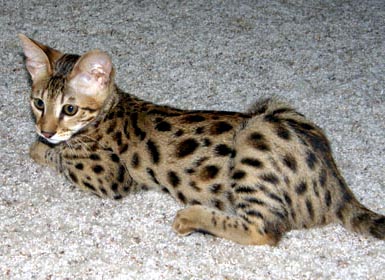
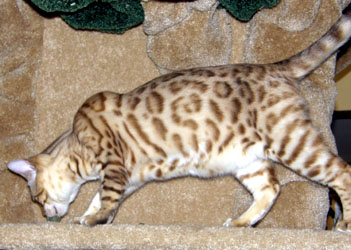
Pictured above are two very different cats from
our cattery, Foothill Felines Bengals/Savannahs.
Left is Patticakes, a high percentage F3
brown spotted Savannah; the Savannah breed standard
calls for
solid, intensely dark and round spots. Pictured above right is Yukon, a seal mink
spotted
Bengal male. The Bengal breed standard calls for
as much shading and multi-colored variations
within the spots as possible, known
as "rosetting". Both these cats are Spotted Tabbies.
 CLICK ON KITTY to return to top of page!
CLICK ON KITTY to return to top of page!
And there are even MORE colors and patterns!! The basic story of the tortoiseshell and calico patterns has to do with the nature of the red color gene. To be identified as tortoiseshell or calico, the cat must show both red and one of the three non-red colors (black, chocolate/brown or cinnamon). The most common tortoiseshell or calico combination is black and red. A calico cat will have a substantial amount of white, and red and black will form distinct patches. On a tortoiseshell cat, the red and black swirl together, with few if any patches. When the tortoiseshell (sometimes called "tortie") and tabby markings are mixed, you will have a torbie, also known as a patched tabby .
 CLICK ON KITTY to return to top of page!
CLICK ON KITTY to return to top of page!
The pointed pattern refers to the pattern wherein the extremeties of the cat are a different (i.e., darker) color than the rest of the animal. The Siamese Cat is usually considered the probable origin or ALL the pointed cats in the United States. There are many other breeds that show color points in their patterns, however; the Ragdoll, the Persian, the Himalayan, the Birman, and such Siamese-variant breeds such as the Javanese, Balinese, and Color Point Shorthair. What are the "points"? The face, legs and tail. There are four basic Siamese colors: Seal (basically, black); Chocolate, Blue, and Lilac. Red, cream, tortoiseshell and lynx point can also occur in the pointed pattern.
In the lynx point cat, the cat has tabby markings (often mackerel tabby) on the face, tail and legs, and the distinctive "M" on the forehead. In most other pointed cats, the colored points are solid. In fact, Burmese, which are bred to appear solid color in appearance, are actually color points. Tonkinese cats, which have one of the Siamese-type color point genes and one of the Burmese-type color point genes, can give us the lovely mink color, which is created with wonderful, very mild shades of color pointing.
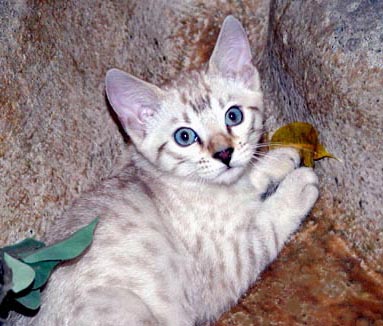
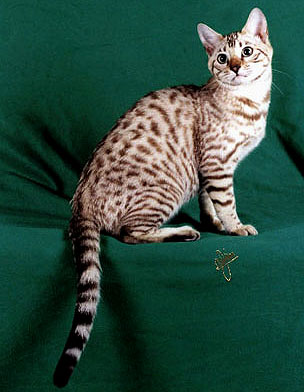
Above are two female snow Bengals from our
breeding program at Foothill Felines. Left is a seal
lynxpoint spotted kitten; note her
intensely blue eye color and light colored spots. Right is our Quad
Champion
Foothill Felines Mochamelo, a seal mink spotted adult. The Burmese influence shows in
Mocha's
aqua eye color and coffee colored spots. Seal minks have one
lynxpoint allele and one
Burmese allele and thus are in a separate genetic
category from the seal lynxpoint and seal sepias.
(Seal sepias are snows with two Burmese alleles; seal lynxpoints
have two lynxpoint alleles.)
 CLICK ON KITTY to return to top of page!
CLICK ON KITTY to return to top of page!
The characteristic COLOR is carried in the same genetic package with the X (or, female) chromosome, meaning that COLOR is a sex-linked feature. Because sex is an easy characteristic to monitor in animals, the coat characteristics can be closely tracked in breeding felines. The XX genetic code is carried by the female, and the XY genetic code is carried by the male. Sometimes, female cats may exhibit something called the "mosaic effect", which occurs when neither X chromosome carries a dominant gene, and females can have two different color genes (one on each X chromosome). BOTH genes can be passed on to their offspring!! This is why the occasional male calico or tortie is almost certainly infertile, as he would have to carry two X chromosomes in addition to the Y chromosome. It is usually the females in a breeding program that are more likely to have multiple color characteristics and less likely to be solid colors.
The white color is dominant to all other colors because the white coloration gene covers up (or, masks) all other colors. Underneath all white cats is a different color cat with all of the genes necessary for other coat patterns and colors; however, the white gene has suppressed them!!
Cats have three different lengths of fur: long, short and plush. Long-haired cats have thick undercoats and very long guard hairs. The two layers may be different colors, which can give the cat a shaded appearance. A cat with a smoky appearance may have a white undercoat with black guard hairs. Short-haired cats have the same thick undercoat, but the guard hairs lay flat along the body and are much shorter. A plush coated cat has a shorter undercoat than the short-haired cat, and the guard hairs are softer and more dense. This coat variation is much finer and softer to the touch as the guard hairs stand out like velvet from the body...however, often the plush coat variation may be less glossy than the short-haired variation. And then, there are the curly-coated cat, which have only an undercoat with no guard hairs, and the hairless cats, which have neither an undercoat nor guard hairs. All these types play a key role in how we see their colors and patterns.
NEW IN 2007: Various laboratories throughout the country (including through our own U.C. Davis, California!!) are now able to test the DNA of kittens from the age of 2 weeks and older ... by swabbing the insides of their cheeks and sending in the DNA sample to the lab for processing. Currently, tests are available for the melanism gene; for certain dilute colors such as blue; and for the sepia and lynxpoint genes. And more are being developed and becoming available to the cat fancy world all the time!!
 CLICK ON KITTY to return to top of page!
CLICK ON KITTY to return to top of page!
|
 | © 1996-2009 Copyright
by HDW Enterprises, Inc. - All Rights Reserved. 
HDW Enterprises, Inc., Cameron Park, CA 95682 (530) 672-CATZ phone http://www.hdw-inc.com e-mail: holly@hdw-inc.com |